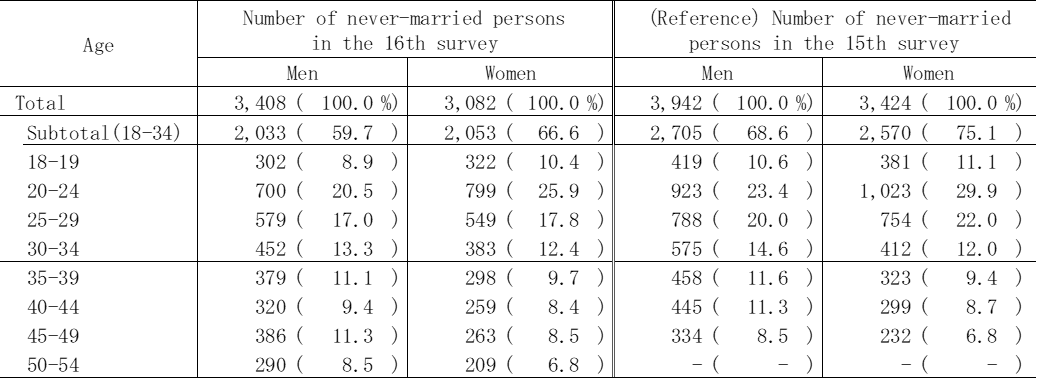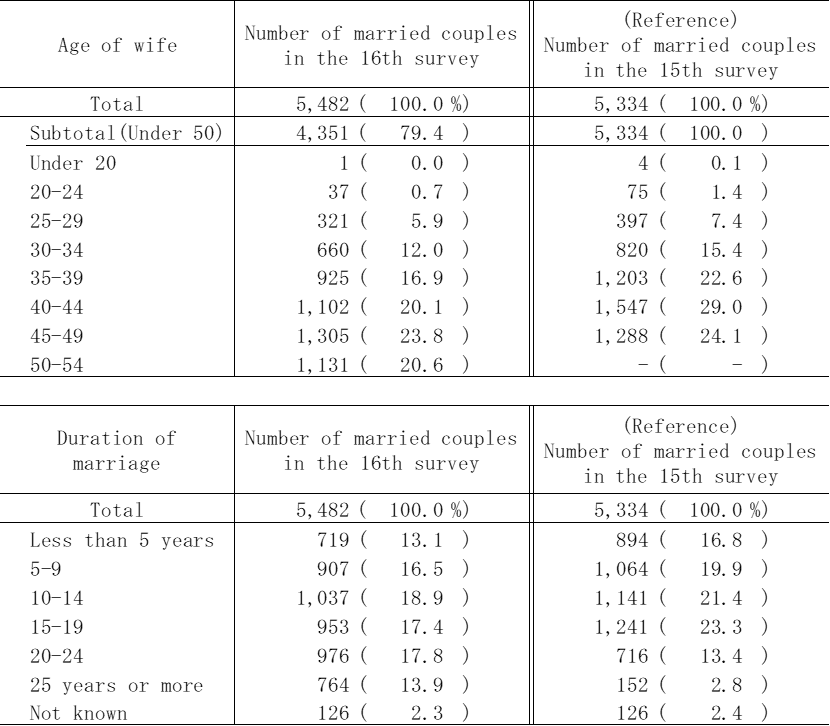![]()
![]()
- Top Page
- Survey:Annual Population and Social Security Surveys
- The 16th Japanese National Fertility Survey
![]()
The 16th Japanese National Fertility Survey
Latest Issue : Released on February 14, 2024
The National Institute of Population and Social Security Research has compiled the results of the Sixteenth Japanese National Fertility Survey (JNFS) conducted in June 2021 (Reiwa 3). The JNFS is conducted periodically to examine marriage and childbearing patterns in Japan to understand population trends and provide basic data for developing policies. It consists of a survey of unmarried men and women and a survey of married women. The 16th survey was originally scheduled to be conducted in June 2020 (Reiwa 2), but it was postponed for one year due to the COVID-19 pandemic.
Survey Results
![]() [Press Release] Sixteenth Japanese National Fertility Survey: Summary of Results
[Press Release] Sixteenth Japanese National Fertility Survey: Summary of Results
![]() Summary of the Survey Results on Married Couples/ Singles
Summary of the Survey Results on Married Couples/ Singles
(This English document is the summary of the Japanese research report published in August, 2023.)
Click here for detailed results of this survey (Japanese only).
Overview of the Survey
The purpose and history of the survey
The National Institute of Population and Social Security Research conducted the 16th Japanese National Fertility Survey (JNFS) (Shussho Doko Kihon Chosa) in June 2021. The JNFS is conducted to examine the current situations of and background to the marriage and fertility of married couples, which are not available in other public statistics, and obtain the basic data necessary for developing relevant policies and projecting the future population. The first JNFS was carried out in 1940 (prewar), and the second in 1952 (postwar). Since then, it has been conducted every five years, investigating the process of marriage and fertility of married couples. Since the 8th Survey (1982), a survey of singles has been conducted simultaneously with that of married couples.
Survey procedures and data collection
This survey was conducted by self-enumeration method.
The questionnaires were distributed by survey staff, and the respondents placed the completed questionnaire in the envelopes provided before they were collected by the staff.
The survey was undertaken in 1,000 districts selected by systematic sampling from the 1,106 districts where the Comprehensive Survey of Living Conditions, 2021, was conducted by the Ministry of Health, Labour and Welfare. The 1,106 districts were initially selected by a stratified random sampling procedure from the 2015 Population Census tracts.
All single persons aged 18 to 54 living in all households in these 1,000 districts were the subjects of the single persons survey, and married women aged under 55 were the subjects of the married couples survey.
[Survey on Unmarried Men and Women]
Of the 14,011 distributed questionnaires (number of survey targets), 8,401 questionnaires were collected, yielding a response rate of 60.0% (the figure was 84.5% for the previous survey). 575 of the collected questionnaires that were not properly filled out were considered invalid and were excluded from the analysis. Thus, the number of valid questionnaires was 7,826, and the valid response rate was 55.9% (76.5% for the previous survey). This report presents the results of the analysis based on the responses of never-married men and women aged 18 to 34 (unless otherwise stated).
[Survey on Married Women]
Of the 9,401 distributed questionnaires (number of survey targets), 7,060 questionnaires were collected, yielding a response rate of 75.1% (the figure was 91.4% for the previous survey). 226 of the collected questionnaires that were not properly filled out were considered invalid and were excluded from the analysis. Thus, the number of valid questionnaires was 6,834, and the valid response rate was 72.7% (87.8% for the previous survey). This report presents the results based on 5,482 first-marriage couples (*).
[*: In this report, the term “first-marriage couples” will be used to refer to couples for whom the current marriage is the first one for both husband and wife.]
Table 1 Numbers of questionnaires distributed and returned, and valid response rate

Table 2 Number of never-married persons, by sex and age (Survey of Singles)

Table 3 Number of couples in first-marriage, by the wife's age and by duration of marriage (Survey of Married Couples)

No permission is required to cite the results of this survey as long as the source of information is clearly stated.
Refer to this page ("Term of use") for details on citing.
It would be appreciated if the user would provide information through the Contact page on how the survey results are used/cited.


